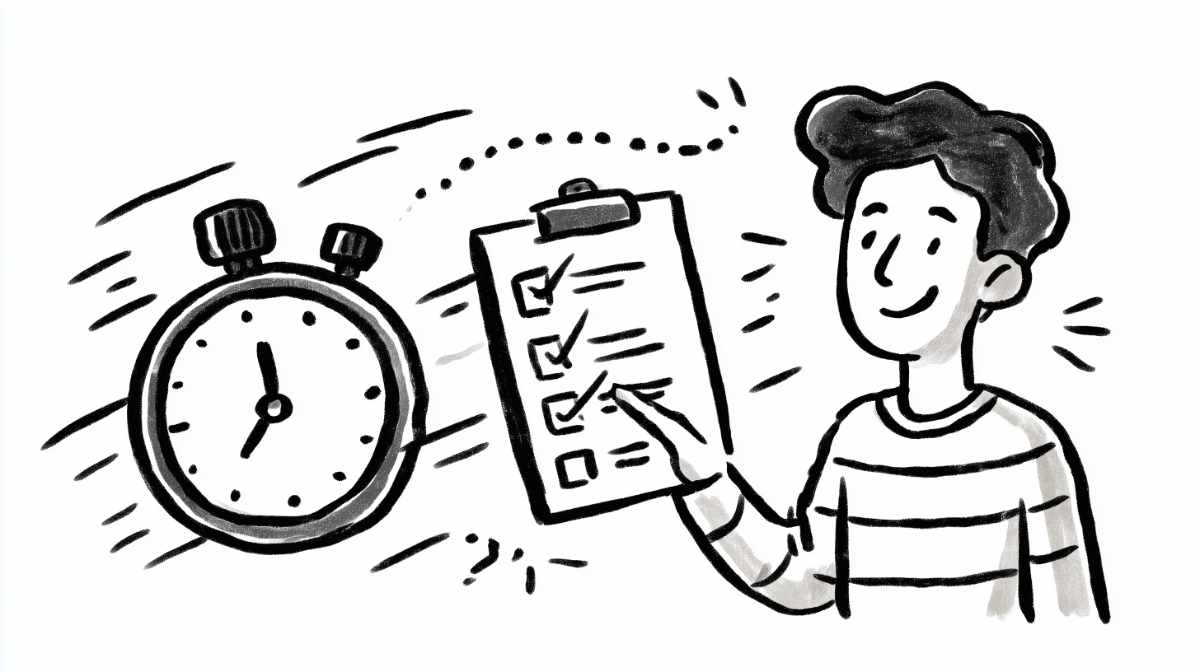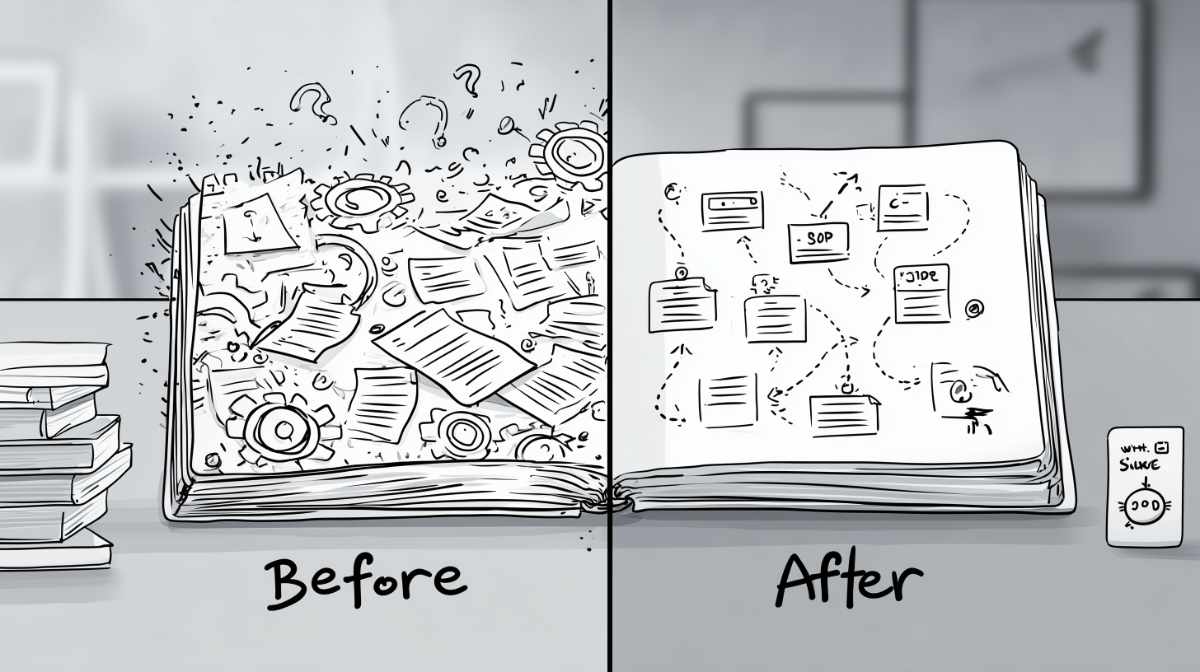AI projects with business promise efficiency and insight, yet too many executives and business owners don’t know where start or watch programs budgets balloon, or slow to a crawl,and staff confidence wane. The root problem is rarely the technology—it’s the absence of clear, documented ways of working that AI can plug into. Standard operating procedures (SOPs) turn scattered tribal knowledge into a single source of truth. Who does what, when, and with which data.
SMBs typically achieve 15-25% productivity improvements1, 33% sales increases through better process consistency, significant reductions in training costs, decreased errors and rework, improved employee retention, and enhanced compliance capabilities.2 – long before AI gets involved. With that foundation in place, AI agents and AI systems have something solid to build upon, and automate, or augment.
In this blog post we will show why SOPs must come before the shiny AI platform and how to weave documentation into every phase of implementation, from readiness audits to change management. Whether you lead a lean start-up or a multi-site enterprise, the steps are the same: map critical workflows, set data rules, define human checkpoints, then measure success against the baseline you’ve captured. Follow along and you’ll avoid the common traps, cut deployment time, and prove tangible returns to your board—without overwhelming your team.
Ready to turn business routines into an AI launchpad? Let’s get started.
Standard Operating Procedures – The Bedrock of AI Readiness
A documented workflow is more than a tidy checklist. It’s the factual baseline that AI programmers follow to implement AI within the workflow. When every task, trigger, and hand-off lives in one place, the discovery phase speeds up because the team isn’t chasing tribal knowledge across departments. Instead of guessing which data fields matter or who approves what, the AI engineers can focus on model design and testing—work that directly affects the timeline and budget signed off at the board table.
“Organisations with comprehensive SOPs consistently achieve superior results in AI implementation; they function as the essential knowledge architecture that powers effective adoption.” 3
Once you have that single source of truth, spotting the best automation wins becomes straightforward. Frequency-impact matrices reveal high-volume, high-value tasks ripe for machine support, while risk scoring keeps critical human checks in view. Using the same documentation, leaders can run a quick readiness assessment—rating each workflow on data quality, compliance exposure, and strategic importance. The result is a ranked hit list that aligns AI investment with board-level objectives, not guesswork.
How to Run a CEO-Level AI Readiness Audit
Start by listing every repeatable workflow on a single sheet—no matter the department. For each one, record its data inputs, decision points, average cycle time, and pain signals such as rework, delays, or customer complaints. While this process might seem time consuming, this inventory highlights where effort and resources drain away—and where targeted AI pilot
programs could deliver immediate relief.
Next, score each workflow on three axes:
1) Strategic value – does it directly affect margin or customer loyalty?
2) Data health – are the inputs complete, accurate, and accessible?
3) Risk tolerance – can errors be tolerated or do they trigger fines?
A simple 1-to-5 scale turns those scores into a heat map, helping the C-suite see which processes earn top priority for automation.
Finally, review the regulatory and ethical checkpoints. Request that the legal team identify any fields containing personal or sensitive data and specify where a human sign-off is required. This step helps prevent potential roadblocks, satisfies auditors, and reassures staff that oversight will remain in place.
With the audit complete, you have a ranked shortlist—evidence-based and board-ready—for the first wave of AI programs.

Designing AI-Ready SOPs – Data Standards, Section-by-Section Roll-Out & Live Benchmarks
Begin with crystal-clear data rules. For every step in the workflow, list the fields an AI program will read, the format each field must follow, and the system of record that supplies it. When customer orders always arrive in the same columns (i.e. dates in ISO, currencies in AUD) engineers can move straight to testing instead of cleansing spreadsheets. Build in spot checks; weekly for high-volume feeds like order data, monthly for slower ones, so drift never sneaks through.
Next, decide where the first AI add-ons sit. Mark low-risk, repetitive tasks—such as validating stock levels or routing routine support tickets—for early automation, and flag sections needing human judgement or extra compliance checks for phase two.
Pay attention to the hand-off points included in the Standard Operating Procedure (SOP), which connect each action to a specific metric, like dollars saved per order, minutes reduced from turnaround time, and errors per thousand transactions.
Since these targets are embedded in the document, the metrics can automatically establish its baseline. This allows leaders to have a single view of whether a pilot program is achieving its goals, requires adjustments, or should be paused before progressing further in the workflow.
This phased, metrics-first approach transforms the SOP into both a roadmap and a safety net, making each expansion step faster and significantly less risky.
Launch & Scale – Measuring Success Against SOP Baselines
As soon as your first AI program goes live, compare real-world metrics with the “pre-AI” numbers captured in the SOP. Use the same units—dollars, minutes, error counts—so the reports need no translation. A simple dashboard that shows before/after deltas keeps the executive team focused on outcomes, not technical jargon. When the model beats the baseline and stays inside tolerance limits, you have proof to unlock further funding.
Treat each deployment as an experiment. Run a controlled pilot program, log results for at least one full cycle (billing period, production batch, customer journey), and feed the findings back into the SOP. If cycle time drops 30 % but error rates tick up, the document should trigger an automatic human review step. This closed loop of baseline-compare-update ensures the system improves without drifting into risky territory as you scale across departments.

Change Management – Turning SOPs Into a Culture of AI Adoption
Clear documentation reduces the mystery factor. When staff can open an SOP and see exactly which tasks the AI programs handle, what data feeds it, and where human sign-off still applies, resistance drops.
People know their expertise remains valued, and they gain confidence that the technology is subject to the same rules as any other tool. Build this trust early by hosting short walkthrough sessions: show the old process, the updated SOP, and the first performance dashboard side-by-side.
Questions shift from “Will I lose my job?” to “Can the AI program handle this edge case?”—a far more productive conversation.
Long term, embed continuous improvement into the document itself. Add a quarterly review line that names who must assess outcomes, update thresholds, and refresh training data. Reward teams that spot process shifts first, perhaps by giving them early access to new AI features or professional-development credits.
By linking model performance, governance checks, and staff development in the same living document, you replace ad-hoc change with a repeatable rhythm. Over time, that rhythm becomes part of the organisation’s DNA, making each subsequent AI rollout faster and less disruptive than the last.
Action Plan & Resources
Complete the free AI-Readiness SOP Questionnaire—a scorecard that lets you grade each workflow on documentation quality, data consistency, and automation potential. Run the checklist with your leadership team this week, you’ll leave the meeting holding a ranked roadmap for your first AI pilot programs.
Ready to accelerate? Book a Process-Mapping Workshop with Duelling Pixels. Our strategists walk your team through one high-impact workflow, document every step, and deliver a draft SOP plus an AI-fit assessment you can present at the next board meeting.
From there, choose an AI pilot program, set the baseline, and start measuring real gains—often within a single quarter.

Leave a Reply